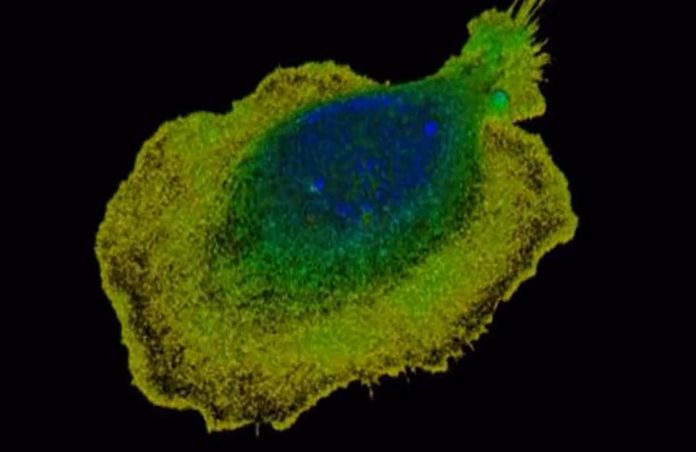People suffering from certain lung diseases, such as asthma and COVID-19 or cancer, create mucus that is 2,000 times thicker than normal.
Scientists found that cells have “ruffles” that look like fins and help them feel how thick mucus is and know when to change shape to move through it.
Researchers from the University of Toronto, Johns Hopkins University, and Vanderbilt University have observed that certain cells move strikingly faster in viscous fluids, such as honey as opposed to water or mucus as opposed to blood since their ruffled edges perceive the viscosity of their surroundings and adapt to increase their speed.
Their findings suggest that the viscosity of a cell’s environment is a significant factor in disease and may help explain tumor progression, scarring in mucus-filled lungs affected by cystic fibrosis, and the wound-healing process. These findings were combined in fibroblast cells, the type of cell that frequently forms scars in tissues, and cancer cells.
The findings of the study were reported in Nature Physics today.
Sergey Plotnikov, a co-corresponding author of the work says: “This link between cell viscosity and attachment has never been demonstrated before.
“We found that the thicker the surrounding environment, the stronger the cells adhere to the substrate and the faster they move – much like walking on an icy surface with shoes that have spikes, versus shoes with no grip at all.”
Cancerous tumors generate a viscous environment, which implies that spreading cells can migrate into tumors faster than non-cancerous tissues. Understanding why cells act in this unexpected way is critical. Since the researchers saw that cancer cells moved faster in a thicker environment, they came to the conclusion that cancer cells with ruffled edges might help the disease spread to other parts of the body.
On the other hand, focusing on the fibroblast spreading response may lessen tissue damage in the mucus-filled lungs afflicted by cystic fibrosis. Ruffled fibroblasts are the first type of cells to pass through the mucus to the wound because of their fast movement, which contributes to scarring rather than healing. These findings may also suggest that one can regulate cell migration by altering the mucus’ viscosity in the lung.
As explained by Ernest Iu, co-author of the study, “by showing how cells respond to what’s around them, and by describing the physical properties of this area, we can learn what affects their behaviour and eventually how to influence it.”
“For example, perhaps if you put a liquid as thick as honey into a wound, the cells will move deeper and faster into it, thereby healing it more effectively,” continues Plotnikov.
Plotnikov and Iu measured changes in structural molecules inside the cells as well as the traction the cells exert to move using cutting-edge microscopy techniques. They looked at cells with rough edges like cancer cells and fibroblast cells and compared them to cells with smooth edges. They discovered that ruffled cell edges perceive the thicker environment and react by flattening out, spreading out, and latching on to the surface in order to help the cell break through the barrier.
The study’s lead author, assistant professor of mechanical engineering Yun Chen, and its first author, PhD candidate Matthew Pittman, started the experiment at Johns Hopkins by first analyzing the motion of cancer cells. Pittman made a thick polymer solution that was like mucus. He put it on different kinds of cells and saw that cancer cells moved through the thick liquid faster than normal cells. Chen worked with U of T’s Plotnikov, an expert in the push and pull of cell movement, to further investigate this behavior.
Plotnikov was surprised by the change in speed when the liquid got thick and sticky.
“Normally, we’re looking at slow, subtle changes under the microscope, but we could see the cells moving twice as fast in real time, and spreading to double their original size,” he adds.
Normally, myosin proteins, which assist in muscle contraction, are required for cell movement. Plotnikov and Iu thought that stopping myosin would stop cells from spreading, but they were surprised to see that the cells still moved faster even though myosin had been stopped. Instead, they found that the thick liquid made the columns of the actin protein, which helps muscles contract, more stable. This made the edge of the cell move out even more.
Scientists are currently looking into ways to restrict the spread of ruffled cells through dense environments, which may pave the way for brand-new cancer and cystic fibrosis treatments.
Image Credit: Still from the video
You were reading: Shock New Discovery Suggests Certain Cells Move Faster Than Blood – Video
